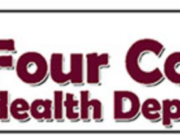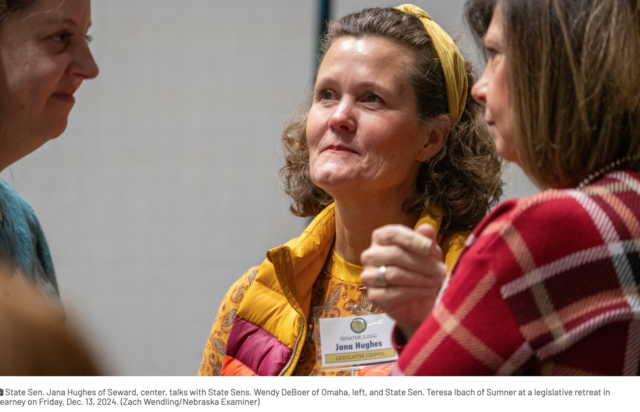Bill would lower top school tax rates by 3 cents, seeking to funnel more state funds toward public schools to lower property taxes.
Nebraska Examiner Press Release
By: Zach Wendling
LINCOLN — Education advocacy organizations and the state’s largest rural-focused organizations largely endorsed an “incremental” proposal Monday to reform Nebraska’s core school finance formula.
Legislative Bill 303, from State Sen. Jana Hughes of Seward and introduced at the request of Gov. Jim Pillen, would bring down maximum school property tax rates by 3 cents, from $1.05 to $1.02.
More state funds would be funneled toward the state’s 245 school districts using the state aid formula, the Tax Equity and Educational Opportunities Support Act (TEEOSA) passed in 1990. TEEOSA includes many funds that amount to a district’s “equalization aid,” based on “needs” minus “resources.”
For the 2024-25 school year, 75% of the state’s school districts did not receive equalization aid. The Hughes effort continues a push by her and Pillen to increase the number of districts receiving equalization aid. The bill also would increase recently established “foundation aid,” by 6%, to $1,590 from $1,500 roughly per each K-12 student.
The state would invest nearly $120 million in new state funding over the next two years, which is included in Pillen’s recommended budget as a strategic investment, in a year where the state must close a projected $432 million budget deficit.

In addition, LB 303 would create a 15-member School Finance Reform Commission, consisting of superintendents, the state education commissioner, lawmakers and representatives from the Nebraska Department of Education. The goal of that group is to find longer-term solutions.
“This is a little bite at the apple, and I hope we keep making chunks at it as we go forward,” Hughes told the Education Committee, where she serves as vice chair.
‘Uncertain budget circumstances’
Hughes, a former school board member for Seward Public Schools, said school finance has been “largely left on auto steer for decades.” She said she appreciated Pillen’s willingness to start pulling some levers in the formula “to steer us on a new course.”
Hughes has dedicated her time in the Legislature to school finance reform. In her second year last summer, for Pillen’s desired special session, she proposed a 10-year plan to lower maximum property tax rates.
By the end of her “Lower The Levy Cap” plan, the state would have taken on a majority of operational expenses for schools to reverse increasing reliance on property taxes.
Pillen had a similar goal, but his summer plan sought to take on all operational expenses, eliminating the general fund property tax rate for schools, before lawmakers pivoted to Hughes’ model, which fell short in the 17-day special session.
The governor repeated his ambition Monday that the state should fund, but not run, local K-12 schools. He said the state must find a balance among federal, state and local funding.
“School districts often live under uncertain budget circumstances,” Pillen said. “That’s not the way to educate and have a focus on our kids.”

Hughes received widespread support at the hearing, including from the:
- Educational Service Unit Coordinating Council (ESUCC).
- Greater Nebraska Schools Association (GNSA).
- Nebraska Association of School Boards (NASB).
- Nebraska Council of School Administrators (NCSA).
- Nebraska Rural Community Schools Association (NRCSA).
- Nebraska State Educational Association (NSEA).
- Schools Taking Action for Nebraska Children’s Education (STANCE).
- OpenSky Policy Institute.
- Nebraska Farm Bureau and the Ag Leaders Working Group with Nebraska Cattlemen, Nebraska Corn Growers Association, Nebraska Pork Producers Association, Nebraska Sorghum Producers Association, Nebraska Soybean Association, Nebraska State Dairy Association, Nebraska Wheat Growers and Renewable Fuels Nebraska.
- Nebraska Farmers Union.
- Individual school districts: Lincoln Public Schools, Milford Public Schools, Millard Public Schools and Papillon-La Vista Community Schools.
Omaha Public Schools opposition
Shane Rhian, chief financial officer for Omaha Public Schools, was the lone opponent testifying against Hughes’ bill. He argued the bill would hurt OPS’s budget in the near future and amount to “another erosion of local control.”
Rhian said one variable that could impact OPS the most is the full district might no longer qualify for universal free lunch and breakfast soon, leading to a projected loss in $30 million in state aid, approximately 9 cents for property taxes.

He suggested keeping the current $1.05 lid for property tax rates, keeping foundation aid at $1,500 (which was established in 2023) but reducing the assumed portion that districts could contribute in the TEEOSA formula.
TEEOSA currently sets this “local effort rate” as the hypothesized value that school districts could contribute as $1 per $100 of valuations in the district. This goes into the “resources” side of the equation, essentially hurting school districts that have lower tax rates.
Hughes’ bill would drop this to 97 cents, in line with her 3-cent drop in the maximum tax lid.
Rhian said it should be 96 cents, without reducing the top tax rate cap, which would put the state on the hook for more funding to schools. It would not lower how much schools can raise in property tax rates.
“We appreciate Senator Hughes and the governor for their commitment to funding public schools and stand ready to be a partner in lowering the property tax burden for our patrons,” Rhian said.
OPS has taken the stance of opposing legislation that could cause the district, the largest in the state, to be more reliant on state funding, earning the ire of some past committee members.
Incremental progress is needed
Andrew Rikli, superintendent of Papillion-La Vista Community Schools, the fourth largest district in the state, said dropping the maximum tax rate can provide substantive tax relief.
He and Liz Standish, associate superintendent for business affairs for Lincoln Public Schools, said they appreciated the bill represented an incremental step and that there would be a commission to help understand the complex formula.
“As much as we might want to make a major change, for those of us that work in school finance day to day, there’s a lot of moving parts and you get really nervous about unintended consequences really quickly,” Standish said.
Rikli said the commission over time can best monitor and respond to changes as needed, rather than perennial updates since the law’s enactment in 1990.

Tim Royers, president of the NSEA, representing 26,000 teachers statewide, recommended including school board members, chief financial officers or frontline educators and not just superintendents. He and Hughes noted the commission will need to fix the proposed group’s membership so lawmakers are nonvoting members of the executive branch commission, as required under the constitutional separation of powers.
‘Doable piece of legislation’
Royers described LB 303 as “the best school funding bill to come from the governor’s office in at least a decade.”
The NSEA generally stays neutral on TEEOSA-related bills, because of different district-level impacts, but NSEA supports the across-the-board increase in foundation aid.
Pillen created that model to give all districts roughly $1,500 per student. LB 303 would increase that to $1,590 under Hughes bill, while bills from State Sens. Dave Murman of Glenvil and Wendy DeBoer of Omaha could lead to greater foundation aid overall, based on inflation or a district’s specific needs.
Colby Coash, on behalf of the school boards association, said his members appreciated the increased state investment in LB 303 for being an “easily scalable bill.”
“But more than that, and in comparison to what we saw happen in the special session and previous sessions, we think this is a doable piece of legislation and it keeps local control central, which is really important to our members,” Coash said.
Hughes said that if the state has additional funds, such as through a lower-than-projected deficit or increased revenue possibly through sales taxes, it would be used to lower valuations inside TEEOSA. This includes agricultural land, which has seen valuations skyrocket.
State Sens. Tom Brandt of Plymouth and Myron Dorn of Adams, both farmers, partnered with Hughes on her bill. They identified about two dozen “luxury” items and services, such as dating services or pet grooming, that are currently sales tax exempt that they say could be used to bring in new revenue for tax relief.

Future TEEOSA reform
Bruce Rieker, senior director of state legislative affairs for the Farm Bureau, cautioned the committee that members must not stop. He noted that in the next two years, property taxes would increase by approximately $600 million, meaning even with LB 303, that’s an increase of $475 million statewide.
Hughes said her long-term goal is moving school property tax rates statewide closer together. Over time, she said the state can focus more on student success and teacher or staff retention.
“It is a small step, but it is a step in the right direction,” Hughes said of her bill. “If we can keep going down this path and whittling away this, I think we can get into a place where we’re all in a better spot.”
Dave Welsch, a farmer and current school board president for Milford Public Schools, with more than 33 years of school board experience, told the Education Committee he’s worked intensively the past 10 years around the TEEOSA formula.
He said the formula needs to be reviewed every year but encouraged a more comprehensive review and offered what he called “The Simple Plan.” It seeks to repurpose the “resources” side of TEEOSA and bring maximum property tax rates down to 45 cents. To do so, Welsch proposes repurposing the state’s existing property tax relief programs and finding $240 million.
“LB 303 makes some steps in the right direction,” Welsch said. “But if you don’t have a target to aim at, you’re going to miss it every time. Taking small steps, sometimes you get off track.”



































